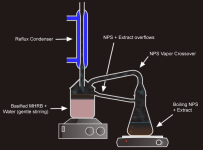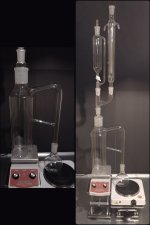IridiumAndLace
Stardust in lingerie
For those who don't know, continuous liquid/liquid extraction is an extraction technique where your solvent is boiled in a receiving flask, travels up into a condenser, and then drips down into your extraction vessel. Once the solvent reaches a particular height in the extraction vessel, it overflows through a tube back into the receiving flask (taking the extracts with it), creating a closed loop. In theory, you could extract virtually all of the spice in the starting material using such an apparatus.
I recently came across the opportunity to obtain the glassware for a continuous liquid/liquid extraction, at a very good price. I've read people talking about this several times, but has anyone here actually attempted it?
Seems like while the crude product would likely be heavily contaminated and would most certainly need a mini a/b and re-x, in theory one could remove virtually all of the spice from an MHRB solution this way, with minimal effort (and cleaning glassware). Plus, there's a theory going around that boiling in heptane is good for yields and quality.
Are there any pitfalls to this that I ought to know about before I give this a try?
Edit: Here's a schematic diagram of how this extraction works. The boiling flask and condenser are separate pieces, the rest is all one (elegant) piece of glass.
I recently came across the opportunity to obtain the glassware for a continuous liquid/liquid extraction, at a very good price. I've read people talking about this several times, but has anyone here actually attempted it?
Seems like while the crude product would likely be heavily contaminated and would most certainly need a mini a/b and re-x, in theory one could remove virtually all of the spice from an MHRB solution this way, with minimal effort (and cleaning glassware). Plus, there's a theory going around that boiling in heptane is good for yields and quality.
Are there any pitfalls to this that I ought to know about before I give this a try?
Edit: Here's a schematic diagram of how this extraction works. The boiling flask and condenser are separate pieces, the rest is all one (elegant) piece of glass.





